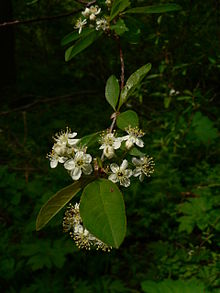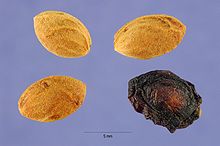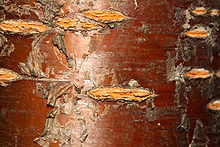- Prunus emarginata
-
Oregon cherry Prunus emarginata leaves and flowers Scientific classification Kingdom: Plantae (unranked): Angiosperms (unranked): Eudicots (unranked): Rosids Order: Rosales Family: Rosaceae Genus: Prunus Subgenus: Cerasus Species: P. emarginata Binomial name Prunus emarginata
(Dougl. ex Hook.) EatonOregon cherry or Bitter cherry (Prunus emarginata) is a species of Prunus native to western North America, from British Columbia south to California, and east to western Wyoming and Arizona. It is often found in recently disturbed areas, open woods, on nutrient-rich soil.[1][2][3]
Contents
Description
Prunus emarginata is a deciduous shrub or small tree growing to 1–15 m tall with a slender oval trunk with smooth gray to reddish-brown bark with horizontal lenticels. The leaves are 2–8 cm long, thin, oval-shaped, and yellowish-green with unevenly-sized teeth on either side. The flowers are small, 10–15 mm diameter, with five white petals and numerous hairlike stamens; they are almond-scented, and produced in clusters in spring, and are pollinated by insects. The fruit is a juicy red or purple cherry 7–14 mm diameter, which, as the plant's English name suggests, are bitter. As well as reproducing by seed, it also sends out underground stems which then sprout above the surface to create a thicket.[2][3]
There are two varieties:[2][4]
- Prunus emarginata var. emarginata. Usually shrubby; young shoots and leaves hairless or only thinly hairy. Most of the species' range.
- Prunus emarginata var. mollis (Dougl.) Brew. A larger tree; young shoots and leaves downy. Oregon north to British Columbia, mainly coastal.
Cultivation
It has hybridized with the introduced European Prunus avium in the Puget Sound area; the hybrid has been named as Prunus × pugetensis. It is intermediate between the parent species, but is nearly sterile, producing almost no cherries.[5]
Uses
The cherries are not very palatable and have been known to cause illness in humans, but animals, especially birds, forage on them.
Medicinal
Native tribes, most notably Kwakwaka'wakw, used other parts of the plant for medicinal purposes, such as poultices and bark infusions.[6] The isoflavone prunetin has been isolated for the first time by Finnemore in 1910 in the bark of P. emarginata[7].
References
- ^ Germplasm Resources Information Network: Prunus emarginata
- ^ a b c Plants of British Columbia: Prunus emarginata
- ^ a b Jepson Flora: Prunus emarginata
- ^ USDA Plants Profile: Prunus emarginata
- ^ Jacobson, A. L. & Zika, P. F. (2007). A new hybrid cherry, Prunus × pugetensis (P. avium × emarginata, Rosaceae), from the Pacific Northwest. Madroño 54: 74–85. Abstract
- ^ Casebeer, M. (2004). Discover California Shrubs. Sonora, California: Hooker Press. ISBN 0-9665463-1-8
- ^ Isoflavones. III. The structure of prunetin and a new synthesis of genistein. R. L. Shriner, C. J. Hull, J. Org. Chem., 1945, 10 (4), pp 288–291
External links
 Media related to Prunus emarginata at Wikimedia CommonsCategories:
Media related to Prunus emarginata at Wikimedia CommonsCategories:- Cherries
- Flora of California chaparral and woodlands
- Flora of the Sierra Nevada region (U.S.)
- Flora of the California desert regions
- Flora of the Western United States
- Flora of the West Coast of the United States
- Flora of the Northwestern United States
- Flora of Oregon
- Traditional Native American medical plants
- Garden plants of North America
- Bird food plants
- Honey plants
- Drought-tolerant plants
Wikimedia Foundation. 2010.



